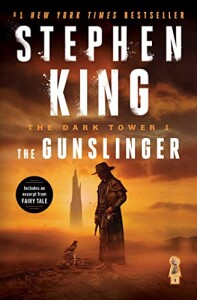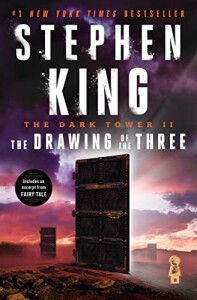“The man in black fled across the desert, and the gunslinger followed.”
With those deceptively straightforward words, world-renowned horror writer Stephen King launches (and rather neatly sums up) the first volume of his sprawling epic fantasy series The Dark Tower. Setting the stage for publication of the fifth book in the series later in 2003, Viking republished a revised hardback version of the first book — soon to be followed by books two through four — complete with a new introduction and forward by King … and thirty-five pages worth of brand new text scattered throughout. The Gunslinger‘s genesis dates back to the early days of King’s career, around 1970 or so, and was first published in 1982. In King’s own words, the original book was the work of a young man, and out of step with the series as a whole, so he revisited it to tighten up the language, plotting and characterization. (King has indicated he’d eventually like to repeat this process with the other books — something to look forward to indeed.)
King’s other well-known forays into straightforward fantasy are much tighter in scope — 1984’s The Talisman and its sequel Black House written with fellow horror writer Peter Straub, and 1987’s standalone novel Eyes of the Dragon — though astute readers of the Dark Tower series will see the connections between these (or just about any other King novel, for that matter) and this series. Unlike any of those novels, The Gunslinger is not intended to stand completely on its own. It has to be read for what it is, our first tentative steps alongside the gunslinger Roland as he strives towards the man in black and the world-spanning Dark Tower.
Roland is the last of a dying breed, the last of a dying age: a worn and weathered man with naught left but his guns, his memories and an unyielding desire, nay, overweening need, to overtake the man in black. We meet Roland as he’s chasing his quarry across a nameless, faceless wasteland, always behind, but slowly, inexorably closing the distance.
While we know little about Roland at this point, we discover quite quickly that he’s good at dealing death with those guns of his. Exceptionally good. Despite this skill, Roland is not yet without the ability to care. There is some small affection between him and the saloon-keeper Allie, whom he dallies with in the miserable town of Tull, and something akin to familial love blossoms between the gunslinger and the boy Jake, whom the man in black maneuvers from New York City to Roland’s side in this strange land. But it’s not his strong suit.
Roland’s tale switches back and forth between his present-day journey across the desert and his remembrances of the past. Through his memories we begin to learn of Gilead, his childhood home; how he came into his birthright, and of Marten, who cuckolded his father … and who is either the man in black’s underling, or one and the same as him. Present day Roland works his way across the desert, joined after a time by Jake, who will serve as his key to palaver with the man in black at the end. Before that meeting, though, Roland must learn of his ka-tet, those who will be bound to him in the longer journey to come, thus setting up book two of the series, The Drawing of the Three. His meeting at last with the man in black is not quite what Roland expects. For rather than the end of his journey, the culmination of all his efforts, Roland finds himself instead embarking on the beginning, as his opponent reveals the existence of the Dark Tower itself, nexus to all worlds. And though he hadn’t really known it until now, it’s the Tower Roland seeks.
Robert Browning’s “Childe Roland to the Dark Tower Came” is an obvious inspiration for King, but the story, and this Roland, are all his. The Gunslinger is light on actual action, but makes up for it with King’s extraordinary characterization of Roland. Roland is someone to fear, admire, love and … follow. And those in search of a fine story will follow Roland to the ensuing volumes, to the bitter end.
The second volume of Stephen King’s Dark Tower series picks right up where the first volume, The Gunslinger left off. Fresh from his palaver with The Dark Man, Roland has traveled to the Western Sea in search of the other members of his “ka-tet” (those spiritually bound to follow him on his quest). Unfortunately for Roland, before he can even determine which way to follow the beach, King unleashes one of the most horrific literary critters ever on him ? the intelligent, carnivorous crustaceans he calls lobstrosities. Before you can count to three, Roland, whose life depends on his skill with his pistols, finds himself at the tender mercy of razor-sharp claws.
The scene is brutal, startling and a reminder that this series is not business as usual, but something different and special. Few authors would inflict such a level of cruelty on their protagonists — and especially not so early in a book or series — but King does, and Roland not only survives, but is probably the stronger in the long run for the tribulation.
In the short term, though, Roland is in trouble. Serious trouble. Infected and weakening and running dangerously low on live ammunition, he determinedly follows the coastline, uncertain when or how he’ll find the people he’s looking for — The Prisoner, The Lady of Shadows and Death. Roland meets no one on the beach, but he does stumble across a door. Yes, a door, on the beach. It’s a quite mysterious door, framed by air and opening into The Prisoner’s world … and into his mind. And so Roland meets Eddie, prisoner to a major heroin addiction. Roland must save Eddie from not only the ravages of heroin, but the thugs that control the young man’s life. The gunslinger’s reward? A companion in the throes of withdrawal … and a week’s worth of Keflex.
Back in Roland’s world, once Eddie is past the D.T.s and Roland has recuperated somewhat, they set off down the beach again, surviving on lobstrosity meat. A second door presents itself in short order, opening to the same place — New York City — but a different time. And in a matter of seconds, Roland enters the door and yanks the Lady of Shadows back to his world. Or rather, the Ladies, for in the wheel-chair-bound body of the woman Roland kidnaps are two very different women: the intelligent, soft-spoken civil rights champion, Odetta Holmes, and the violent, hate-spewing, slang-slinging Detta Walker.
Eddie falls immediately for Odetta, but unfortunately for both men, wily, vengeful Detta reigns supreme for most of their remaining trip down the beach, a situation that puts their lives on the line when Roland, again ailing, and nearly dead, enters the third door and catapults into an unspeakably vile mind. Death — the aptly named Jack Mort — is a bizarre link between the boy Jake (sacrificed by Roland in the first book), Odetta and Detta. Roland makes use of him to obtain new bullets, a month’s worth of Keflex and, ultimately, to fuse Odetta and Detta into a third woman, Susannah, his actual Lady. This newly forged threesome — Roland, Eddie and Susannah — form the tower-bound ka-tet, whose journey King will chronicle in the books to follow.
The relationship between Roland and Eddie, an uneasy, uncertain friendship born of necessity, illuminates and drives The Drawing of the Three. The two men could not be more different, and more than once, Eddie considers killing the weakened gunslinger. But something — fate, perhaps — stays his hand. The pair are as much two halves of one whole person as are the two halves of Odetta’s mind. Odetta and Susannah make but brief appearances in the book, a bit of calm around the storm that is Detta. Detta is foul, crass and very over-the-top, but her bravado performance as Odetta’s id is necessary for further defining the relationship between the two men and setting the stage for Susannah’s entrance.
And King has himself set the stage, with this second volume of exquisitely detailed character introduction, for the extraordinary adventure to unfold in book three. Always a master of small details, King here turns that talent loose on his characters, unveiling new aspects of each player with each turn of the card. Readers are treated to more of Roland in action … and Roland learning, the hard way, to trust his companions, as he must, if the quest is to be completed. King peppers the book with humour — Roland discovering the joys of highly-sweetened, caffeinated soft drinks is delightful — keeping the serious tone from becoming overwhelming. The action in New York City is fast-paced and suspensful, balancing well the agonizingly slow (for the ka-tet, not for the readers!) trip down the beach. And neatly, King hints at the third book The Waste Lands through the tarot references on the doors, seemingly drawn from Eliot’s famous poem — Roland as the Drowned Sailor/Death, Odetta/Detta/Susannah as the Lady of Situations/Lady of Shadows and Eddie as the Hanged Man/Prisoner.
In the third installment of his on-going Dark Tower series, King picks right back up with the team-building theme of the previous volume, as Roland the Gunslinger continues to hone the skills of his companions and finally draws their fourth (Jake Chambers, the boy he sacrificed in Book One) to his world.
Having prevented the death of young Jake at the end of the second book, Roland has created a split in reality, resulting in one universe in which Jake is alive (the boy’s reality), and one in which he’s dead (Roland, Eddie and Susannah’s reality). Both man and boy suffer dramatically because of this dichotomy, their minds slowly being torn asunder by the dissonant dual existence of both realities. This poses a grave danger to Susannah and Eddie, who fear what might happen if and when the gunslinger slides fully into dementia… but with his unparalleled shooting skills intact.
Aware of the incipient threat, Roland pushes the lovers to their limits during training, preparing them for the time when he may be more danger than help. Early scenes featuring the party focus on Roland’s slide into insanity, and Eddie and Susannah’s ascent as gunslingers. There is a terrifying encounter with one of the twelve Guardians of the world, an immense cybernetic Bear by the name of Shardik (an amusing reference to Richard Adams), and further evidence of the Old Ones, whose technology litters this world. The group finds the bear’s base, a world-spanning electronic gate and the Beam which emanates from it. The Beam which becomes their path towards the Tower.
In his own world, New York City of the 1970s, Jake’s grip on sanity is becoming as tenuous as Roland’s. Some part of him knows he should be dead, yet here he is, still attending prep school, still the child of indifferent parents, longing for the affirmation and affection of a man in another world who once let him die. Jake’s waking days begin to overlap with Eddie’s dreams as the moment of his cross-over draws nigh, until their paths literally cross and Jake almost meets a younger Eddie (with his still-alive brother Henry). Jake’s passage to Roland’s world is fraught with peril, but successful, and his crossing heals the wounds in their minds, if not necessarily their hearts.
With the ka-tet now complete, the foursome follow the Beam deeper into the land, encountering no one at first, and then stumbling across a pocket of gentle, generous long-lived inhabitants, who are in awe of meeting an honest-to-goodness living gunslinger. They tell Roland’s group about the war-torn city of Lud, and, chillingly, about Blaine the monorail, whom Jake wrote about in his other life (yet another example, like Shardik, of the thin line between the worlds). The group’s leave-taking is heartbreakingly sad, but vitally necessary.
In Lud the group is split, Eddie and Susannah speeding to Blaine’s “cradle,” Roland chasing down Jake, who has been kidnapped by one of Lud’s warring factions. They meet up again at the station, boarding Blaine for what will be the trip of a lifetime, for Blaine is not only sentient and riddle-loving, but rather insane, with a suicide wish. King closes the book infuriatingly (for there were several years between its last page and the ensuing volume!) with a compromise being drawn between Roland and Blaine: the ka-tet will riddle Blaine until the end of his track. If they stump him, he lets them live. If he answers every riddle… they die with him.
King’s writing is, as in the previous volumes, wonderfuly descriptive and crisp, dropping more hints about the present nature – and past history – of Mid-World. Eddie and Jake are more fully fleshed out here, the former finally shedding the shadow of doubt that is his brother’s legacy, the latter showing courage and intelligence beyond his years, without being precocious. Even the addition of an intelligent animal – Oy, the billy-bumbler (a badger-like critter), who attaches himself to Jake – typically a sure-fire way to slide into unbearable cuteness, is handled with aplomb. With the ka-tet complete, and readers hooked, King can now turn his attention to their journey to the Tower … and venture further into Roland’s past, topics which will define the remaining volumes in the series.
(Viking, 2003)



